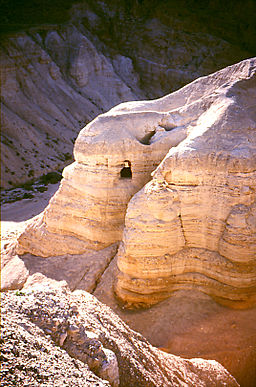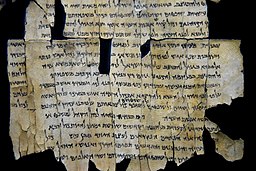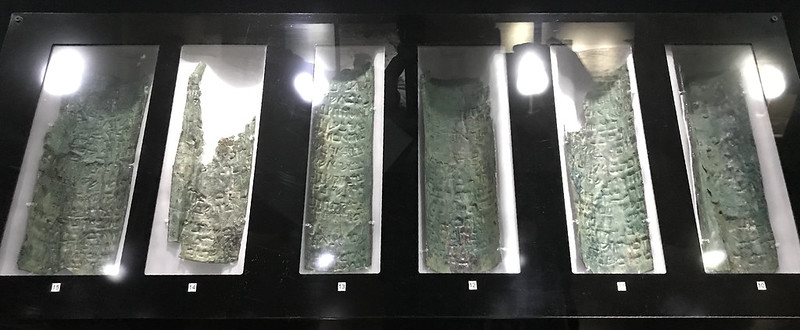The Copper Scroll
History
The Copper Scroll

Since its discovery in 1952, The Copper Scroll has baffled archeologists, scholars, and the public alike. The Copper Scroll is comprised of 99% copper and 1% tin. [1] This deviates from the rest of The Dead Sea Scrolls it was found among. The majority of The Dead Sea Scrolls are comprised of parchment or papyrus. The Leon Levy Dead Sea Scrolls Digital Library has been committed to transcribing and digitizing as many of the scrolls as they can. Here you can view the scrolls digitized so far.

On March 14th 1952, archeologists found The Copper Scroll, along with 14 other Dead Sea Scrolls, in Cave 3 near Qumran on the northern shore of the Dead Sea in the West Bank. Because of the location of its discovery, The Copper Scroll is also referred to as 3Q15. A list of the other scrolls discovered in Cave 3 can be found here. The exact date of the scroll's creation is unknown. Some scholars think it dates somewhere between 66-70 C.E., the First Jewish Revolt against Rome. This would be before the destruction of the Jerusalem Temple in 70 C.E. [2] Joan E. Taylor, writer of "Secrets of the Copper Scroll" published in Biblical Archaeology Review, believes the date to be closer to the Second Jewish Revolt against Rome between 132-135 C.E. [3] Evidence has been found Jewish refugees from the revolt took shelter at caves near where The Copper Scroll was found during this period.
The first of The Dead Sea Scrolls were found in late 1946 and early 1947 by a Bedouin shepherd who stumbled upon the scrolls while herding goats and sheep. [4] The young shepherd came across large clay jars that contained the scrolls. He brought the scrolls to Kando, a Bethlehem antiquities dealer. The shepherd was misled about their value and sold them to Kando as well as Salahi, a second antiquities dealer. [5] Kando then sold them to the Syrian Orthodox Monastery of St. Mark in Jerusalem. From there, Dr. John C Trever from ASOR caught wind of their discovery and found many similarities in the text to the Nash Papyrus (the oldest biblical manuscript known). The Dead Sea Scrolls are the second oldest known biblical text. There are 11 caves in total. 981 manuscripts and fragments of manuscripts have been found in the caves. The last of the scrolls were found in 1956. Currently, the Dead Sea Scrolls are held in the Shrine of the Book at The Israel Museum. The ownership of the scrolls is heavily disputed.

The Copper Scroll differs from the rest of The Dead Sea Scrolls in its materiality, but also by a number of other factors. The Hebrew used in The Copper Scroll is not the literary Hebrew found on the other Dead Sea Scrolls. The Hebrew is closer to the language of the Mishnah. The script used to write the letters and the way the words are spelled (palaeography and orthography) differ as well. Unlike the other scrolls, this is the only manuscript in list form and one that refers to a buried treasure of sorts. [6] This has led scholars to conclude the scroll was placed in Cave 3 at a different time than the rest of the Dead Sea Scrolls.
When the scroll was found, the thin copper was heavily oxidized and too brittle to unroll. In 1955 and 1956, the scroll was cut into 23 strips using a small saw. [7] The scroll was approximately 8 feet long and one millimeter thick. John Marco Allegro oversaw the opening of the scroll and set about transcribing it as soon as he could. [8]
The part of The Copper Scroll that has excited and baffled most individuals throughout history is its contents. The scroll is said to list directions to 64 places where treasure can be found.
The first column of the scroll begins In the fortress which is in the Vale of Achor, forty cubits under the steps entering to the east: a money chest and it [sic] contents, of a weight of seventeen talents.
-The Copper Scroll
The scroll details tons of gold, silver, coins, and vessels. [9] The contents of the scroll have led to one of the largest ongoing treasure hunts in history. However, none of the pieces off the list have been found. Some of the words in the scroll remain unknown. Some locations are extremely specific with no starting point and other locations no longer exist. This has led scholars, such as Gerald Lankester Harding and Frank Moore Cross, to state The Copper Scroll is folklore. [10] Furthermore, it is debated who the treasure belongs to if it does indeed exist.
Modern Day
The Copper Scroll is the subject of many books, including but not limited to The Copper Scroll by Joel C. Rosenberg, John Allegro's The Treasure of the Copper Scroll and Sean Young's Violent Sands.
As said above, many have gone in search of The Copper Scroll's treasure. Most notably, Oklahoma arson investigator Jim Barfield. Barfield set out on a decade long journey to find the treasures detailed in the scroll. [11] He maintains the site The Copper Scroll Project about his journey and The Copper Scroll. However, The Copper Scroll Project is only granted observation status for the Israel Antiquities Authority's digs.
In 2007, The Copper Scroll was put on display for the first time in the United States at the San Diego Natural History Museum. The exhibition lasted six months. This was rare, as the Israel Antiquities Authority allows scrolls to be exhibited for three month periods only.
Since 2013, The Copper Scroll has been on display in the Jordan Museum in Amman. Photos of the display from the Jordan Museum are visible here.
Discussion of The Copper Scroll
The Copper Scroll is notable for being the only scroll found in the Qumran caves made out of copper. Copper is a substrate intended to last. The durability of the material (compared to the papyrus of other scrolls) points to the contents of the manuscript being authentic. Copper and bronze were common materials for archival records. In the Philippines, Burma, and Italy around the same time, it was common to see copper, brass, and thin gold plates used for important documents. To "write" on copper requires a hammer and chisel to imprint. Each word was done with intentionality.
As mentioned above, The Leon Levy Dead Sea Scrolls Digital Library has been slowly but surely digitizing all available scrolls. The digitizing of such fragile artifacts allows for worldwide accessibility. At the same time, it changes the way we as individuals connect with, and assign importance to, documents almost 2,000 years old.
Notes
- ↑ “Dead Sea Copper Scroll, Jordan Museum. Art Destination Jordan.” Universes in Universe - Worlds of Art. https://universes.art/en/art-destinations/jordan/amman/museums/jordan-museum/photos/dead-sea-copper-scroll.
- ↑ “Dead Sea Copper Scroll, Jordan Museum. Art Destination Jordan.” Universes in Universe - Worlds of Art. Accessed November 28, 2020. https://universes.art/en/art-destinations/jordan/amman/museums/jordan-museum/photos/dead-sea-copper-scroll.
- ↑ Taylor, Joan E. “Secrets of the Copper Scroll.” Biblical Archaeology Review 45, no. 4, 2019. https://www.baslibrary.org/biblical-archaeology-review/45/4/13.
- ↑ “Discovery and Publication.” The Dead Sea Scrolls - Discovery and Publication. Israel Antiquities Authority, 2012. https://www.deadseascrolls.org.il/learn-about-the-scrolls/discovery-and-publication?locale=en_US.
- ↑ “Discovery and Publication.” The Dead Sea Scrolls - Discovery and Publication. Israel Antiquities Authority, 2012. https://www.deadseascrolls.org.il/learn-about-the-scrolls/discovery-and-publication?locale=en_US.
- ↑ Meir Bar-Ilan, "The Process of Writing the Copper Scroll", 2002. http://faculty.biu.ac.il/~barilm/coperite.html.
- ↑ Zuckerman, Bruce. “Copper Scroll.” Copper Scroll > West Semitic Research Project > USC Dana and David Dornsife College of Letters, Arts and Sciences. Accessed November 28, 2020. https://dornsife.usc.edu/wsrp/copper-scroll/.
- ↑ Zuckerman, Bruce. “Copper Scroll.” Copper Scroll > West Semitic Research Project > USC Dana and David Dornsife College of Letters, Arts and Sciences. Accessed November 28, 2020. https://dornsife.usc.edu/wsrp/copper-scroll/.
- ↑ Zuckerman, Bruce. “Copper Scroll.” Copper Scroll > West Semitic Research Project > USC Dana and David Dornsife College of Letters, Arts and Sciences. Accessed November 28, 2020. https://dornsife.usc.edu/wsrp/copper-scroll/.
- ↑ Cargill, Robert R. “On the Insignificance and the Abuse of the Copper Scroll.” On the Insignificance and the Abuse of the Copper Scroll | Bible Interp, July 2009. https://bibleinterp.arizona.edu/opeds/copper.
- ↑ Neese, Shelley. The Copper Scroll Project: an Ancient Secret Fuels the Battle for the Temple Mount. Google Books. New York: Morgan James Publishing, 2019. https://www.google.com/books/edition/The_Copper_Scroll_Project/Dj1lDwAAQBAJ?hl=en&gbpv=0.